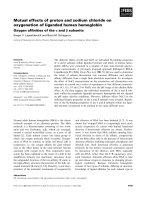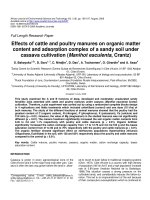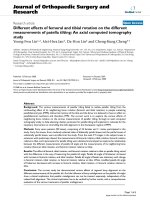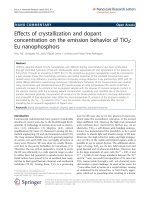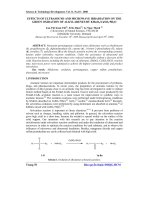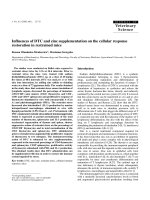Effects of glucocorticoids and retinoic acid on activated rat microglial cells in primary culture
Bạn đang xem bản rút gọn của tài liệu. Xem và tải ngay bản đầy đủ của tài liệu tại đây (1.48 MB, 200 trang )
EFFECTS OF GLUCOCORTICOIDS AND
RETINOIC ACID ON ACTIVATED RAT
MICROGLIAL CELLS IN PRIMARY
CULTURE
ZHOU YAN, M.D.
A THESIS SUBMITTED FOR THE DEGREE OF
DOCTOR OF PHILOSOPHY
DEPARTMENT OF ANATOMY
YONG LOO LIN SCHOOL OF MEDICINE
NATIONAL UNIVERSITY OF SINGAPORE
2007
ii
ACKNOWLEDGMENTS
I am deeply indebted to my supervisor, Dr S. Thameem Dheen, Assistant
professor, Department of Anatomy, National University of Singapore, for his constant
encouragement, invaluable guidance and infinite patience throughout this study.
I am very grateful to Professor Ling Eng Ang, Head of Anatomy Department,
National University of Singapore, for his constant support and encouragement to me
as well as his valuable suggestions to my project, and also for his full support in using
the excellent working facilities.
I would like to acknowledge my gratitude to Mdm Du Xiao Li, Mrs. Ng Geok
Lan and Mrs Yong Eng Siang for their excellent technical assistance; Mr. Yick
Tuck Yong for his constant assistance in computer work and Mrs. Carolyne Wong,
Ms Violet Teo and Mdm. Diljit Kour for their secretarial assistance.
I also wish to thank all staff members and my fellow postgraduate students at
Department of Anatomy, National University of Singapore for their assistane one way
or another.
Certainly, without the financial support from the National University of
Singapore, in terms of Research Scholarship and National Medical Research Council
in terms of a research grant (NMRC/0680/2002) to Dr Dheen, this work would not
have been brought to a reality.
Finally, I am greatly indebted to my husband, Mr Deng Yiyu for his constant
encouragement, patience and help during my study.
iii
This thesis is dedicated to
my beloved family
iv
PUBLICATIONS
Various portions of the present study have been published or submitted for
publication and are in preparation.
International Journals:
1. Yan Zhou, EA Ling, and ST Dheen. Dexamethasone suppresses monocyte
chemoattractant protein-1 production via mitogen activated protein kinase
phosphatase-1 dependent inhibition of Jun N-terminal kinase and p38
mitogen-activated protein kinase in activated rat microglia. J Neurochem. 102,
667-678 (2007).
2. S. T. Dheen,*, Yan Jun*, Yan Zhou*, SSW Tay, and EA Ling. Retinoic acid
inhibits expression of TNF-
and iNOS in activated rat microglia. Glia, 50(1),
21-31 (2007).
*S. T. Dheen, Yan Jun, Zhou Yan contributed equally to this work.
3. Chun-Yun Wu, Charanjit Kaur, Jia Lu, Qiong Cao, Chun Hua Guo, Yan Zhou,
Viswanathan Sivakumar, Eng Ang Ling. Transient expression of endothelins in the
amoeboid microglial cells in the developing rat brain. Glia, 54(6), 513-25 (2006)
4. Dheen, S T, J LU, Yan Zhou, C Kaur and E A Ling, "Activation and inhibition of
microglial functions: An overview". In: Trends in Glial Research-Basic and Applied,
ST Dheen and EA Ling. Research Signpost, 2007, 59-69. .
5. Yan Zhou, Xiaoli Du, E A Ling, S T Dheen, Retinoic acid inhibits proliferation of
activated rat microglia by regulating the cell cycle associated proteins. Manuscript in
preparation, 2007.
Conference Abstracts:
1. Yan Zhou, YQ Huo, Xiaoli Du, EA Ling, S. T. Dheen, Dexamethasone inhibits
MCP-1 production via MKP-1 dependent inhibition of JNK and p38 MAPK in
activated rat microglia. Society for Neuroscience, Neuroscience 2006, Atlanta, GA,
USA, 2006.
2. Yan Zhou, SSW Tay, EA Ling and ST Dheen Glucocorticoids inhibit expression of
some chemokines (MCP-1 and MIP-1α) in activated rat microglia in vitro, presented
at VII European Meeting on Glial Cell Function in Health and Disease, Amsterdam,
Netherlands, 2005.
v
3. Yan Zhou, Hong Yao, SSW Tay, EA Ling and S T Dheen, Glucocorticoids inhibit
expression of some chemokines (MCP-1 and MIP-1A) in activated rat microglia in
vitro. International Biomedical Science Conference, Kunming, China, 2004.
4. Yan Zhou, Xiaoli Du, E A Ling and S T Dheen, Retinoic acid inhibits proliferation
and inflammation of activated rat microglia. 7th IBRO World Congress of
Neuroscience, Melbourne, Australia, 2007.
vi
TABLE OF CONTENTS
ACKNOWLEDGEMENTS ii
DEDICATION iii
PUBLICATIONS iv
TABLE OF CONTENTS vi
ABBREVIATIONS xiv
SUMMARY xvii
Chapter 1: Introduction 1
1.1. Origin of microglia
2
1.2. Functions of microglia
3
1.2.1. Phagocytosis
4
1.2.2. Release of cytokines and chemokines
4
1.2.3. Release of proteases
7
1.2.4. Generation of reactive oxygen species (ROS) and nitrogen
intermediates
7
1.2.5. Migration
8
1.2.6. Upregulation of antigen-presentation cell (APC) capabilities
9
1.2.7. Proliferation
10
1.3. Microglia activation
13
1.3.1. Activation of microglia by various stimuli
13
vii
1.3.1.1. Lipopolysacharide 13
1.3.1.2. β-Amyloid
13
1.3.1.3. Interferon -γ
14
1.3.1.4. Thrombin
15
1.3.1.5. Granulocyte-Macrophage colony stimulating factor and
Macrophage colony stimulating factor
16
1.3.2. Signaling pathways mediating microglial activation
17
1.3.2.1. Mitogen-activated protein kinase pathways
17
1.3.2.2. Nuclear factor-κB pathway
19
1.3.3. Microglia activation in neurodisorders
19
1.3.3.1. Alzheimer’s disease
20
1.3.3.2. Parkinson’s disease
21
1.3.3.3. Multiple sclerosis
22
1.3.3.4. HIV associated dementia
22
1.4. The role of microglia during neurogenesis and synaptogenesis
in the brai n
24
1.5. Inhibition of micrglial activation may improve therapeutic strategy
for neurodegenerative disease
26
1.5.1. Glucocorticoids
27
1.5.2. Retinoic acid
28
1.5.3. Minocycline
29
1.5.4. Vitamin D
30
viii
1.5.5. Endocannabinoids 31
1.5.6. TGF-β1
31
1.5.7. Chondroitin sulfate proteoglycan
32
1.5.8. PPARγ agonists
33
1.6. Aims of the present study
34
1.6.1. To examine the effects of Glucocorticoids (GCs) on the
chemotaxic activity of activated microglia
35
1.6.2. To study the effects of all-trans-retinoic acid (RA) on
microglial activation and proliferation.
36
Chapter 2: Materials and Methods 38
2.1. Animals and microglia primary culture
39
2.1.1. Animals
39
2.1.2 Materials
39
2.1.3 Procedure
40
2.1.3.1. Removal of brain cultures
40
2.1.3.2. Mechanical dissociation of brain tissue
41
2.1.3.3. Enzymatic digestion
41
2.1.3.4. Microglia purification
42
2.2. Treatment of microglia culture
43
2.2.1. Materials
43
2.2.2. Procedure
44
ix
2.3. Immunofluorescence labeling 45
2.3.1. Principle
45
2.3.2. Materials
46
2.3.3. Procedure
46
2.4. RNA Isolation and Real time RT-PCR
47
2.4.1. Principle
47
2.4.2. Materials
50
2.4.3. Procedure
51
2.4.3.1. Extraction of total RNA
51
2.4.3.2. cDNA synthesis
52
2.4.3.3. Real-time RT-PCR
53
2.4.3.4. Detection of PCR product
54
2.5. ELISA
55
2.5.1. Principle
55
2.5.2. Materials
55
2.5.3. Analysis of MCP-1 by ELISA
55
2.5.4. Analysis of TNF-α by ELISA
56
2.6. Nitrite assay
56
2.6.1. Principle
56
2.6.2. Materials
57
2.6.3. Procedure
57
2.7. Western blot assay
57
x
2.7.1. Principle 57
2.7.2. Materials
58
2.7.3. Procedure
61
2.8. In vitro Chemotaxis assay
62
2.8.1. Materials
62
2.8.2. Procedure
63
2.9. Cell proliferation assay
64
2.9.1. Principle
64
2.9.2. Materials
65
2.9.3. Procedure
65
2.10. BrdU incorporation assay
66
2.10.1. Principle
66
2.10.2. Materials
67
2.10.3. Procedure
67
2.11. Statistical Analysis
68
Chapter 3: Results 69
3.1. Microglial cells in primary culture
70
3.2. Dex suppressed MCP-1 production in activated microglia via inhibition
of MAP kinase pathway
70
3.2.1. Dex inhibited the MCP-1 mRNA expression in activated microglial
cells
70
xi
3.2.2. Dex inhibited the MCP-1 protein expression and release in
activated microglial cells
71
3.2.3. Dex suppressed the LPS-induced JNK and p38 MAP Kinases
activation in microglial cells
71
3.2.4. Dex inhibited LPS-induced c-Jun phosphorylation in
microglial cells
72
3.2.5. Dex suppressed MCP-1 release by inhibiting the JNK and
p38 MAPK pathway in activated microglia
72
3.2.6. Dex inhibited MCP-1 production in activated microglia via
MKP-1 dependent JNK and p38 MAPK pathways
73
3.2.6.1. Dex induced MKP-1 mRNA and protein expression
73
3.2.6.2. Inhibition of MKP-1 expression by triptolide blocked the
inhibitory effect of Dex on phosphorylation of JNK
and p38
74
3.2.6.3. Inhibition of MKP-1 expression suppressed
Dex-induced downregulation of MCP-1 mRNA
expression in activated microglia 74
3.2.7. Dex inhibited the mRNA and protein expression of CCR2 in
activated microglia 75
3.2.8. Dex inhibited MCP-1-mediated migration of microglia to medium
from activated microglial cultures 76
3.3. RA inhibited inflammatory response of activated microglia by
xii
suppressing TNF-α and iNOS expression 77
3.3.1 RA suppressed the expression of TNF-α and iNOS in the microglia
exposed to LPS 77
3.3.2. RA inhibited JNK phosphorylation and induced MKP-1
expression in LPS-stimulated microglia 78
3.4. RA inhibited GM-CSF-induced microglial proliferation by regulating
cell cycle-associated proteins 79
3.4.1. RA inhibited GM-CSF-induced proliferation of microglia 79
3.4.2. RA altered expresseion of cell cycle associated proteins in GM-CSF
stimulated microglia 79
Chapter 4: Discussion 82
4.1. Dex suppresses migration of activated microglia 83
4.1.1. Dex suppresses MCP-1 production and subsequent microglial
migration 83
4.1.2. Downregulation of MCP-1 expression in activated microglial
cells by Dex is mediated via MKP-1-dependent inhibition of JNK
and p38 MAPK pathways 85
4.2. RA suppresses activation and proliferation of microglia 89
4.2.1. RA inhibits the neurotoxic effect of activated microglia by
suppressing the expression of proinflammatory cytokine, TNF-α
and iNOS
89
xiii
4.2.2. RA inhibits GM-CSF-induced microglia proliferation by suppressing
the cell cycle related protein 93
Chapter 5: Conclusions 97
Conclusions 98
Scope for the future study 102
References
104
Figures and figure legends
129
xiv
ABBREVIATIONS
ABC, avidin-biotin conjugate
AD, Alzheimer’s disease
AEA, endocannabinoid anandamide
AP-1, activating protein-1
APC, antigen-presentation cell
APP, amyloid precursor protein
Aβ, β-Amyloid
BBB, blood-brain barrier
BrdU, Bromodeoxyuridine
BSA, bovine serum albumin
B-SA, biotin-streptavidin
bZIP, basic region-leucine zipper
CCR2, chemokine (C-C motif) receptor 2
CJD, Creutzfeldt-Jakob disease
Ct, threshold cycle
DAPI, 4’, 6- diamidino-2-phenylindole dihydrochloride
Dex, Dexamethasone
DMEM, Dulbecco's Modified Eagle Medium
DMSO, Dimethyl Sulfoxide
JNKs, c-jun N-terminal kinases/stress-activated protein kinases
EAE, experimental autoimmune encephalomyelitis
ECL, enhanced chemiluminescence
ERK1/2, extracellular-signal-regulated kinases
GAPDH, glyceraldehydes-3-phosphate dehydrogenase
GCs, Glucocorticoids
GM-CSF, Grannulocyte-Macrophage colony stimulating factor
xv
GR. Glucocorticoid receptor
GREs, glucocorticoid response elements
HIV associated dementia (HAD)
HRP, horseradish peroxidase
IFN-
, interferon -
IGF, insulin-like growth factors
IHC, Immunohistochemistry
IL-1β, interleukin-1β
iNOS, inducible nitric oxide synthase
JNK. C-Jun N-terminal kinase
LPS, lipopolysaccharide
LBP, LPS binding protein
MAC-1, macrophage antigen complex-1
MAPK, mitogen-activated protein kinase
MCP-1, Monocyte chemoattractant protein-1
M-CSF, Macrophage colony stimulating factor
MHC, major histocompatibility complex
MKP-1, MAPK Phosphatase-1
MK2, MAPK-activated protein kinase 2
MS, multiple sclerosis
NADPH oxidase, nicotinamide adenine dinucleotide phosphate-oxidase
NO, Nitric Oxide
NFTs, neurofibrillary tangles
NF-κB, nuclear factor-κB
PAP, peroxidase antiperoxidase
PARs, protease-activated receptors
PBS, phosphate-buffered saline
RT-PCR, reverse transcription-polymerase chain reaction
PI, Propidium iodide
PD, Parkinson’s disease
xvi
PF, paraformaldehyde
PPARγ, peroxisome proliferators-activated receptorγ
PrP, prion protein
RA, all-trans-retinoic acid
RANTES, regulated upon activation, normal T cell expressed and secreted
RARs, retinoic acid receptors
Rb, retinoblastoma
RXRs, retinoid X receptors
ROS, reactive oxygen species
SNpc, substantia nigra pars compacta
SPs, senile plaques
TBI, traumatic brain injury
TLR4, Toll-like receptor 4
TNF-α, tumor necrosis factor-α
TGF-β1, Transforming growth factor-β1
tPA, protease tissue plasminogen activator
15d-PGJ2, 15-deoxy-Delta12,14-prostaglandin J2
An inflammatory process in the central nervous system (CNS) is believed to
play an important role in the pathway leading to neuronal cell death in a number of
neurodegenerative diseases. The inflammatory response is mediated by the activated
microglia, the resident immune cells of the CNS. In response to a variety of stimuli,
microglia undergo rapid proliferation, secrete a number of proinflammatory
cytokines, migrate to the injury sites, and remove the damaged cells by phagocytosis.
Although microglia play a beneficial role in large by removing potentially toxic
cellular debris, it remains controversial whether microglial cells have beneficial or
detrimental functions in various neuropathological conditions. The chronic activation
Summary
xvii
of microglia may cause neuronal damage through the release of potentially cytotoxic
molecules such as proinflammatory cytokines including tumor necrosis factor-α
(TNF-α) and reactive oxygen intermediates. Therefore, suppression of
microglia-mediated inflammation has been considered as an important strategy in
neurodegenerative disease therapy. Several anti-inflammatory drugs have been shown
to repress the microglial activation and to exert neuroprotective effects in the CNS
after different types of injuries. However, these drugs do not specifically target
microglial cells and therefore, exhibit potential systemic side effects. In this study, we
attempted to understand the potential mechanisms and signaling pathways by which
two drugs, glucocorticoids (GCs) and all-trans-retinoid acid (RA), suppress the
activation of microglial cells in CNS diseases.
Dexamethasone inhibits chemotaxic activity of microglia: Microglial cells release
monocyte chemotactic protein-1 (MCP-1) which is believed to amplify the
inflammation process by recruiting macrophages and microglia to the inflammatory
sites in CNS diseases. GCs are widely used anti-inflammatory and
immunosuppressive drugs in several neurological diseases. Recently, it has been
shown that GCs could inhibit LPS-induced MCP-1 production in the hippocampus
and cortex (Szczepanik and Ringheim 2003; Little et al. 2006). However, the
molecular mechanisms by which GCs regulate MCP-1 expression in activated
microglial cells have not been elucidated. It has been reported that GCs
counter-regulate mitogen-activated protein kinase (MAPK) signaling pathways, in
particular p38 and Jun N-terminal kinase (JNK) pathways by inducing expression
Summary
xviii
MAPK phosphatase-1 (MKP-1) (Clark 2003). Moreover, activation of MAP Kinases
in microglial cells, leads to phosphorylation of transcription factors such as
c-Jun/AP-1 resulting in induction of expression of some target genes including TNF-α,
and MCP-1 (Babcock et al., 2003; Waetzig et al., 2005). In view of these observations,
it was hypothesized that GCs inhibit MCP-1 production via MKP-1-mediated
inactivation of MAP Kinases, resulting in decreased microglial migration towards the
sites of inflammation in the CNS. Hence, effects of dexamethasone (Dex), a synthetic
GC on MAP Kinase pathways and expression of MCP-1 in activated microglia as well
as migration of microglia have been investigated using the real time RT-PCR,
immunocytochemistry, Western blot, ELISA and in vitro chemotaxis assay. The
results indicate that Dex suppressed the mRNA and protein expression of MCP-1 in
activated microglia resulting in inhibition of microglial migration. This has been
further confirmed by the chemotaxis assay which showed that Dex or MCP-1
neutralization with its antibody inhibits the microglial recruitment towards the
conditioned medium of LPS-treated microglial culture.
This study also revealed that the downregulation of the MCP-1 mRNA
expression by Dex in activated microglial cells was mediated via MAPK pathways. It
has been demonstrated that Dex inhibited the phosphorylation of JNK and p38 MAP
kinases as well as c-jun, the JNK substrate in microglia treated with LPS. The
involvement of JNK and p38 MAPK pathways in induction of MCP-1 production in
activated microglial cells was confirmed as there was an attenuation of MCP-1 protein
release when microglial cells were treated with inhibitors of JNK and p38. In addition,
Summary
xix
Dex induced the expression of MAP kinase phosphatase-1 (MKP-1), the negative
regulator of JNK and p38 MAP kinases in microglial cells exposed to LPS. Blockade
of MKP-1 expression by triptolide enhanced the phosphorylation of JNK and p38
MAPK pathways and the mRNA expression of MCP-1 in activated microglial cells
treated with Dex.
In brief, Dex inhibits the MCP-1 production and subsequent migration of
microglial cells to the inflammatory site by regulating MKP-1 expression and the p38
and JNK MAPK pathways. This study reveals that the MKP-1 and MCP-1 as novel
mediators of biological effects of Dex may help developing better therapeutic
strategies for the treatment of patients with neuroinflammatory diseases.
Retinoic Acid inhibits neuotoxic effect and proliferation of microglia:
Retinoic acid (RA), the biologically active form of vitamin A, exhibits
anti-proliferatory and anti-inflammatory activities in various cell types (Mathew and
Sharma 2000). It has also been demonstrated that RA is synthesized in the adult
vertebrate brain (Dev et al. 1993;Zetterstrom et al. 1999). In view of these
observations, it is hypothesized that RA may modulate the inflammatory response
and proliferation index of microglia. Hence, we have investigated the effects of RA
on release of proflammatory cytokines and proliferation in activated microglia using
immunocytochemistry, Western blot, and ELISA. It has been shown that RA could
inhibit microglial activation by suppressing their secretions of TNF-α as well as NO
in primary microglia cultures exposed to LPS. This inhibition of TNF-α and NO
syntheses by RA in the activated microglia appeared to be mediated via inhibition of
Summary
xx
NF-κB translocation which could be caused by upregulation of RAR and TGF-β1
gene expression. It has also been shown that RA could inhibit syntheses of TNF-α
and NO in activated microglia by MKP-1-mediated inhibition of JNK MAP kinase
pathway.
Moreover, this study demonstrates that RA inhibits GM-CSF induced
microglial proliferation by
altering the expression of cell cycle associated proteins
such as cyclin D1, E2F transcription factor 1 (E2F-1), Retinoblastoma (Rb) and p27.
Based on the results, it is suggested that RA could be considered a potential
therapeutic agent that may inhibit the expansion and activation of microglia in the
neurodegenerative diseases. However, careful evaluation is needed before RA is
considered for the treatment of neurodegenerative diseases as it modulates a wide
variety of biological processes including proliferation, differentiation and apoptosis
in various cell types.
Introduction
1
Chapter 1
Introduction
Introduction
2
The central nervous system (CNS) consists of neurons and glial cells
including astrocytes, oligodendrocytes and microglia. Microglia were first
recognized in the brain by Nissl in 1899 (Nissl 1899) and constitute about 5-12%
of the total glial population (Ling and Leblond 1973). They play an important role
as resident immune cells in the healthy and diseased CNS. It is generally agreed
that microglia are related to monocytes and belong to the mononuclear phagocyte
lineage (Vilhardt 2005). Microglia display considerable phenotype heterogeneity
during their life cycle such as ameboid, ramified and reactive microglia (Kaur and
Ling 1991). Ameboid microglia found in the developing brain are phenotypically
similar to reactive microglia found in the pathological conditions, both of which
have a large spherical body and short processes. During postnatal stages of
development, the ameboid microglia transform into resting ramified microglia
which are distributed ubiquitously throughout the nervous system including the
optic nerve and retina (Nissl 1899;Kaur et al. 2006b). When ramified microglia
are activated in pathological conditions, they transform into ameboid morphology.
Concurrently, they acquire functions such as induction of inflammation,
phagocytosis and antigen presentation to circulating T cells in order to mobilize
the defence system in the CNS (Aloisi 2001, Vilhardt 2005). Besides serving as
resident immune cells in the brain, microglia also interact dynamically with
neurons and other glial cells, thus fulfilling important neurotrophic roles (Vilhardt,
2005).
Introduction
3
1.1 Origin of microglia
Despite intense study, the precise tissue origin and cell lineage of microglia
are still at the centre of debate. Unlike astrocytes, oligodendrocytes and neurons,
which are believed to be derived from neuroectoderm, microglia have been
considered to have originated from (i) neuroectoderm, (ii) peripheral
mesodermal/mesenchymal tissues, or (iii) from circulating blood monocytes
(Chan et al. 2007). The view that is widely accepted by many is the latter - that
microglia are derived from circulating mesodermal hematopoietic cells which in
mammals originate from the yolk sac (Chan et al. 2007). It has been demonstrated
that circulating monocytes or precursor cells of the monocyte-macrophage lineage
invade the developing brain during embryonic, fetal or postnatal stages (Kaur et al.
2001) and transform into microglial cells which express several proteins, specific
for cells of the monocyte/macrophage lineage (Kaur et al. 1984; Kaur and Ling
1991; Ling and Wong 1993). These findings, together with the phagocytic activity
of microglia suggest that microglia are derived from circulating monocytes and
belong to the mononuclear phagocytic system.
1.2 Functions of microglia
In the developing brain, ameboid microglia phagocytose, the cells
undergoing apoptosis, and are also actively involved in the determination of cell
fate (elimination /survival) (Vilhardt 2005). In the adult brain, ramified resting
microglia serve as supportive glial cells and their phagocytic functions are
Introduction
4
downregulated. However, upon stimulation, the ramified microglia undergo a
series of morphological and functional changes in order to respond specifically
and appropriately towards the insult by induction of inflammation, tissue repair,
neurotropic support, or activation of lymphocyes. The upregulation of multiple
immunological functions is referred to as activation and is paralleled by both
morphological transformation and discrete temporal changes in gene expression
(Vilhardt 2005).
1.2.1 Phagocytosis
As macrophages of the CNS, the phagocytic capacity of microglia is well
demonstrated. Microglia are capable in displaying a phagocytotic response to
β-amyloid (Aβ) (Wilkinson et al. 2006), degenerated myelin (Makranz et al.
2006), fibrillar prion peptide (Ciesielski-Treska et al. 2004), and apoptotic and
nonapoptotic damaged cells (Petersen and Dailey 2004). Microglial interaction
with these macromolecules and damaged cells is mediated through an ensemble of
cell surface receptors, and thus pevents their harmful effects.
1.2.2 Release of cytokines and chemokines
Cytokines and chemokines secreted by microglia constitute microglial
communication and effector system. Microglial cytokines and chemokines
regulate innate defense mechanisms, help the initiation of immune responses,
participate in the recruitment of leukocytes into the CNS, and support tissue repair
Introduction
5
and recovery (Hanisch 2002).
Tumor necrosis factor-α (TNF-α) is one of the major proinflammatory
cytokines with pleiotropic functions produced by microglia as well as
blood-derived macrophages during CNS inflammation. In microglia culture,
synthesis and release of TNF-α is induced by pathogens or pathogen components
(such as lipopolysaccharide (LPS) and interferon- γ (IFN-γ)). TNF-α has been
implicated in the development of CNS inflammation mainly through their ability
to induce expression of chemokines and adhesion molecules in cerebrovascular
endothelial cells and astrocytes, which help leukocyte extravasation into the CNS
(Lee and Benveniste 1999).
Chemokines are chemotactic cytokines which act through G-protein-coupled
receptors. Chemokines could participate in directing microglia recruitment to
injured CNS sites and sustain their activation, whereas chemokines produced by
microglia are likely to contribute to leukocyte recruitment and amplification of
CNS inflammation. Chemokines promote migration of microglia to a particular
site in the brain during development and disease processes. In conjunction with
integrins and endothelial cell-adhesion molecule, chemokines are believed to
control the circulation of macrophages, leukocytes and other immune cells
(Ambrosini and Aloisi 2004). A variety of inflammatory chemokines and
chemokine receptors have been described in the brain during disease processes.
Glial cells stimulated by LPS and inflammatory cytokines, TNF-α and IL-1




